 The new DUFOUR 405 GRAND LARGE combines a sweet performance hull and rig with a classic yacht-style interior. The old adage says that whenever you have two boats sailing in the same direction, you have a race. While casual cruisers may deny this, many of us love to see just how well our boats sail in comparison to others. It’s just human nature.
The new DUFOUR 405 GRAND LARGE combines a sweet performance hull and rig with a classic yacht-style interior. The old adage says that whenever you have two boats sailing in the same direction, you have a race. While casual cruisers may deny this, many of us love to see just how well our boats sail in comparison to others. It’s just human nature.
So it was a pleasure to see several other mid-size sloops tacking down Narragansett Bay one afternoon last July when we were out sail-testing the new Dufour 405 Grand Large. We had motored out of the marina at New England Boatworks, rolled out the in-mast furling mainsail and the genoa, and set off to see how the new design sails. The 405 does not come standard with a roller furling mainsail, but this boat had been spec’d out with one by the local dealer Northstar Yacht Sales, so launching the mainsail was a snap.
With twin wheels in the cockpit, I was able to sit to leeward, where I could see the genoa telltales and keep an eye on the mainsail trim. While you can’t see anything to windward from the leeward steering position, I did have a great view of everything to leeward and for me this is the place to sit when sailing upwind.
We threw the 405 through a few tacks to see how she performed and were pleased to see that the boat tacks comfortably inside 85 degrees and makes very little leeway when hard on the wind, even with the optional shoal draft keel. The afternoon sea breeze was building, so we had a pleasant 10 to 12 knots of wind. The 405 sailed comfortably at 7 knots hard on the wind in this breeze.
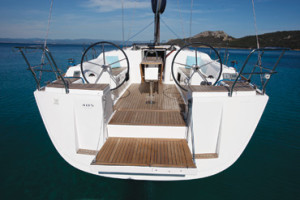 The cockpit is well laid out for handling the sheets with the mainsail trimmed on a winch on the cabintop and the genoa on large cockpit winches that are at a good height and easy to crank. Under the cockpit sole between the twin wheels, a neat life raft locker has been built in. And, the 405’s transom folds down, creating a large and useful stern platform with a retractable swim ladder built into it. We took a long board across the bay so we could engage the other boats tacking southward into the sea breeze. There were two production racer-cruisers in our size range and a couple of smaller boats. We reeled in the smaller guys effortlessly and soon had the larger boats in our sights. We were probably paying closer attention to sail trim than the other guys, but still the 405 sailed higher and faster than they did. From a mile astern, it took us less than an hour to get almost a mile ahead.
The cockpit is well laid out for handling the sheets with the mainsail trimmed on a winch on the cabintop and the genoa on large cockpit winches that are at a good height and easy to crank. Under the cockpit sole between the twin wheels, a neat life raft locker has been built in. And, the 405’s transom folds down, creating a large and useful stern platform with a retractable swim ladder built into it. We took a long board across the bay so we could engage the other boats tacking southward into the sea breeze. There were two production racer-cruisers in our size range and a couple of smaller boats. We reeled in the smaller guys effortlessly and soon had the larger boats in our sights. We were probably paying closer attention to sail trim than the other guys, but still the 405 sailed higher and faster than they did. From a mile astern, it took us less than an hour to get almost a mile ahead.
Satisfied that we had won, we eased sheets and jibed our way back toward the marina. Downwind, the 405 can be sailed wing and wing, but we wanted to see how the boat would do at deep reaching angles. At about 150 degrees apparent wind, with the genoa drawing fully, the 405 slipped along at an easy 7 knots in the 10 to 12 knots of true breeze. The boat seems to make its own wind once it gets in the groove and moving nicely. The new Dufour 405 was a pleasure to handle under sail. The helm was light, the boat sailed very close to the wind, and both up and downwind showed a good turn of speed. Whether cruising or racing, the boat will show her stern to a lot of boats in her class.
LIVING ABOARD
The 405 comes in two- or three-sleeping cabin versions. The boat we sailed had the two-cabin layout with a large centerline double berth forward and a double cabin aft to port. The opposite space where a third cabin could be installed is a handy cockpit locker and garage on the two-cabin version.
Both versions have two heads, with the after head home to the separate shower stall. The after head also has the commode facing forward, which is the best arrangement for use when at sea and heeled over.
 The two-cabin version has an L-shaped “American-style” galley to starboard at the base of the companionway ladder. This will be a good seagoing galley and has plenty of counter and storage space. The fridge has both top and side access. The counters are Corian. The double sinks are in the outboard counter. The under-counter drawers and storage areas are neatly hidden behind doors that can be latched so you will never have the galley’s contents scattered across the floor when the boat lurches on a wave. The two-cabin version does not have a separate chart table, but uses the table between the single seats to starboard as command central. Instruments and the electrical panel are installed outboard. Most owners will install a chartplotter, which will be mounted on the after end of the cockpit table in full view of both helms. The table can be lowered to complete a full length settee that will also be a good sea berth.
The two-cabin version has an L-shaped “American-style” galley to starboard at the base of the companionway ladder. This will be a good seagoing galley and has plenty of counter and storage space. The fridge has both top and side access. The counters are Corian. The double sinks are in the outboard counter. The under-counter drawers and storage areas are neatly hidden behind doors that can be latched so you will never have the galley’s contents scattered across the floor when the boat lurches on a wave. The two-cabin version does not have a separate chart table, but uses the table between the single seats to starboard as command central. Instruments and the electrical panel are installed outboard. Most owners will install a chartplotter, which will be mounted on the after end of the cockpit table in full view of both helms. The table can be lowered to complete a full length settee that will also be a good sea berth.
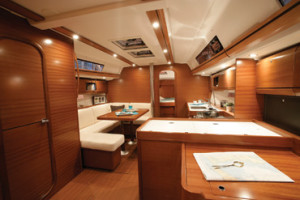 The U-shaped dinette to port seats six with two sitting on the bench amidships. The bench provides a large central storage area. Additional storage is built in under the sole, including a large wine locker with built-in wine racks.
The U-shaped dinette to port seats six with two sitting on the bench amidships. The bench provides a large central storage area. Additional storage is built in under the sole, including a large wine locker with built-in wine racks.
The interior is finished in a mahogany-colored wood called Moabi that has an attractive and traditional feel. The cabin sole is a modern Moabi veneer instead of the traditional teak and holly pattern. The cabintop and sides are off-white panels that really brighten the cabin and give it a Bristol-fashion feel. With two overhead opening deck hatches and opening side ports, the saloon will be well ventilated and bright. For a couple who often sails with friends, the two-cabin version will work nicely. For a family with children, the three-cabin version will certainly work better. In either case, the 405 offers a well thought out interior that works well underway or at anchor and is as modern and elegant as any of the new boats now offered on the market.
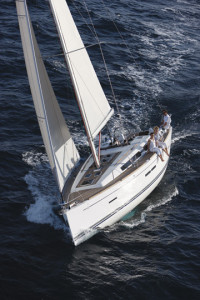 BWS THOUGHTS
BWS THOUGHTS
The Dufour 405 Grand Large does just about everything right despite its somewhat redundant name. The boat sails well and will be fun for competitive sailors and cruisers alike. The boat has a Cat A Offshore rating, so you can feel comfortable taking on long coastal runs or going offshore for a ocean passage.
The cockpit and decks are well laid out, uncluttered and easy to move around, and forward, the anchor system has been set up for easy regular use. The fold-down stern platform will make getting in and out of the dinghy easy and is a great sunning and swimming platform.
The boat’s systems have been installed with regular maintenance and occasional repairs in mind. The engine compartment has good access from three sides. The fuel and water tanks, batteries, plumbing and electrical systems all meet or exceed the top Euro zone regulations and ABYC standards.
The Dufour 405 GL is a production boat with a difference. You can feel the company’s nearly 50 years of boat building experience in every aspect of the boat and can rest assured that it will serve you and your crew well for generations to come.
Dufour 405 Grand Large
LOA 39’10”
LWL 34’10”
Beam 13’2”
Draft (stand.) 6’7”
Draft (shoal) 5’8”
Sail area 881 sq. ft.
Water 100 gals.
Fuel 52 gals.
Engine 40-hp. Diesel
U.S. Contact: Eric Macklin
North American Representative for Dufour Yachts
www.dufour-yachts.com
eric.macklin@dufour-yachts.com
Cell: (352) 871-0362
 Catalina 385 • This mid-size family cruiser combines traditional good looks (and values) with a long list of innovations and refinements
Catalina 385 • This mid-size family cruiser combines traditional good looks (and values) with a long list of innovations and refinements We flew out into the bay and then rolled up the screecher to see how she sailed with the 135 percent genoa. Hard on the wind, the boat maintained a happy 7 knots in the 10 knots of true breeze and tacked inside 90 degrees quite easily. The boat we were sailing has the shoal draft winged keel and a slightly shallower rudder than the deep draft version, but this did not seem to affect her performance upwind and we noted that we were making very little leeway. Again, hard on the wind and heeled to almost 15 degrees, the 385 had a very light helm that was easily balanced with traveler adjustments.
We flew out into the bay and then rolled up the screecher to see how she sailed with the 135 percent genoa. Hard on the wind, the boat maintained a happy 7 knots in the 10 knots of true breeze and tacked inside 90 degrees quite easily. The boat we were sailing has the shoal draft winged keel and a slightly shallower rudder than the deep draft version, but this did not seem to affect her performance upwind and we noted that we were making very little leeway. Again, hard on the wind and heeled to almost 15 degrees, the 385 had a very light helm that was easily balanced with traveler adjustments.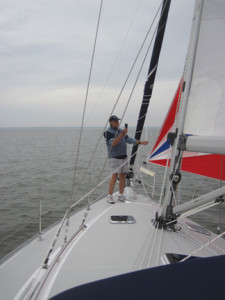 The deck layout works really well for a couple sailing together or a larger group. The mainsail controls and traveler are all managed with line stoppers and a winch next to the companionway. The genoa sheets and control line for the headsail are within reach of the helmsman. The cockpit is not overly wide, so you always have a good foot or hip brace point, which allows you to work with both hands. Visibility from the raised helm seats to windward and leeward is excellent.
The deck layout works really well for a couple sailing together or a larger group. The mainsail controls and traveler are all managed with line stoppers and a winch next to the companionway. The genoa sheets and control line for the headsail are within reach of the helmsman. The cockpit is not overly wide, so you always have a good foot or hip brace point, which allows you to work with both hands. Visibility from the raised helm seats to windward and leeward is excellent. Back in Back Creek we put the boat through its paces under power. At cruising revs she will cruise at 6.5 knots easily and can get close to 8 when pushed. The boat has a nice tight turning radius for maneuvering in close quarters, and with a three-bladed prop will stop in two boat lengths from cruising speed. We had to back her into the marina slip in a crosswind, so we gave ourselves plenty of distance and then backed steadily and surely into the slip and managed to pick up both bowlines on their pilings as we slid by.
Back in Back Creek we put the boat through its paces under power. At cruising revs she will cruise at 6.5 knots easily and can get close to 8 when pushed. The boat has a nice tight turning radius for maneuvering in close quarters, and with a three-bladed prop will stop in two boat lengths from cruising speed. We had to back her into the marina slip in a crosswind, so we gave ourselves plenty of distance and then backed steadily and surely into the slip and managed to pick up both bowlines on their pilings as we slid by.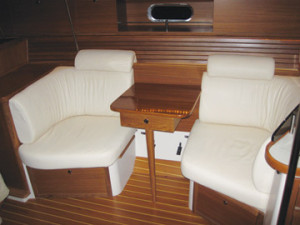 The L-shaped dinette to port has a quad-leaf folding table that will seat several people when open, but takes up very little space when folded. On the boat we tested, the table was varnished to a very high gloss and looked magnificent. Across from the dinette, the twin easy seats are separated by a folding table that will be useful for playing cards or board games. The bench in the dinette will make an excellent sea berth.
The L-shaped dinette to port has a quad-leaf folding table that will seat several people when open, but takes up very little space when folded. On the boat we tested, the table was varnished to a very high gloss and looked magnificent. Across from the dinette, the twin easy seats are separated by a folding table that will be useful for playing cards or board games. The bench in the dinette will make an excellent sea berth. The 385 holds 100 gallons of water, so you will not have to skimp on washing up. Plus, with a six-gallon hot water heater, you should have plenty of hot water for short showers. The guest cabin aft has a large athwartship double berth and a small bench where you can sit while putting on your shoes. Plus, there are large lockers for storage of your guest’s gear and for spare parts and all the sundries cruisers collect along the way.
The 385 holds 100 gallons of water, so you will not have to skimp on washing up. Plus, with a six-gallon hot water heater, you should have plenty of hot water for short showers. The guest cabin aft has a large athwartship double berth and a small bench where you can sit while putting on your shoes. Plus, there are large lockers for storage of your guest’s gear and for spare parts and all the sundries cruisers collect along the way. The forward section of the hull has what Catalina calls the Strike Zone; this is a watertight compartment forward of the forward bulkhead that will prevent water ingress should you run up on a half submerged object such as a container.
The forward section of the hull has what Catalina calls the Strike Zone; this is a watertight compartment forward of the forward bulkhead that will prevent water ingress should you run up on a half submerged object such as a container.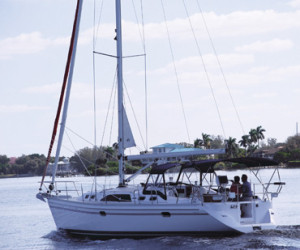 Under the water, Catalina uses lead for their keels and engineers massive, robust stainless steel bolt attachments to the integral hull grid. The rudder is a hand-molded fiberglass part with a stainless steel rudderpost and internal stainless steel framing for strength. The rudder post is fixed in place with a large watertight rudder bearing and is operated via the Edson steering system and quadrant.
Under the water, Catalina uses lead for their keels and engineers massive, robust stainless steel bolt attachments to the integral hull grid. The rudder is a hand-molded fiberglass part with a stainless steel rudderpost and internal stainless steel framing for strength. The rudder post is fixed in place with a large watertight rudder bearing and is operated via the Edson steering system and quadrant.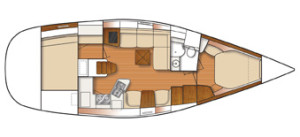 The engineering and construction details that go into modern Catalinas combine the best in traditional production construction techniques with a definite emphasis on quality, not only in the manufactured parts but also in the choice of OEM equipment such as hatches and ports, and optional equipment such as inverters and battery chargers. The company strives to build boats that are safe, sail well, are easy to maintain and will hold value for a long time. In the 385, they have certainly succeeded.
The engineering and construction details that go into modern Catalinas combine the best in traditional production construction techniques with a definite emphasis on quality, not only in the manufactured parts but also in the choice of OEM equipment such as hatches and ports, and optional equipment such as inverters and battery chargers. The company strives to build boats that are safe, sail well, are easy to maintain and will hold value for a long time. In the 385, they have certainly succeeded. Island Packet 360 • This new mid-size bluewater cruiser will make a fine and sensible couple’s cruising boat
Island Packet 360 • This new mid-size bluewater cruiser will make a fine and sensible couple’s cruising boat The 360 sports an all-new interior that combines the warmth of traditional varnished teak joinery with the brightness of light-colored laminates and countertops. The boat offers two large, private double cabins and has a large head forward with a separate shower stall. The galley is huge and has twin refrigerators (either of which can be used as a freezer), a propane stove and oven, a microwave, and plenty of storage above and below the counters.
The 360 sports an all-new interior that combines the warmth of traditional varnished teak joinery with the brightness of light-colored laminates and countertops. The boat offers two large, private double cabins and has a large head forward with a separate shower stall. The galley is huge and has twin refrigerators (either of which can be used as a freezer), a propane stove and oven, a microwave, and plenty of storage above and below the counters. After the Annapolis show, we had the chance to sail the boat before it was delivered to the nearby dealership at Gratitude Yacht Sales. The morning breeze was light and the Chesapeake Bay was lovely in the early autumn warmth. Off the Naval Academy we rolled out the mainsail and then the genoa and the 360 responded nicely. At 19,300 pounds, she is no lightweight, but even so the ample sail area easily turned the light breeze into 5 knots of boat speed. She seemed to almost be making her own wind.
After the Annapolis show, we had the chance to sail the boat before it was delivered to the nearby dealership at Gratitude Yacht Sales. The morning breeze was light and the Chesapeake Bay was lovely in the early autumn warmth. Off the Naval Academy we rolled out the mainsail and then the genoa and the 360 responded nicely. At 19,300 pounds, she is no lightweight, but even so the ample sail area easily turned the light breeze into 5 knots of boat speed. She seemed to almost be making her own wind. At the fixed bridge across the river, we bore off onto a broad reach and rolled out the staysail to give us maximum sail area. The 360 responded well and soon the bow wave was hissing nicely along the hull and the wake stretching away smoothly. This is the kind of pleasant sailing that we would have been happy with all day.
At the fixed bridge across the river, we bore off onto a broad reach and rolled out the staysail to give us maximum sail area. The 360 responded well and soon the bow wave was hissing nicely along the hull and the wake stretching away smoothly. This is the kind of pleasant sailing that we would have been happy with all day.
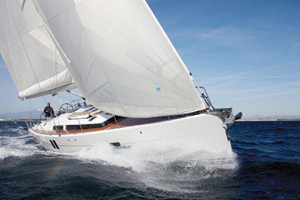 Hanse 495 • The future is here in the new German-built Hanse 495—more space, greater comfort, better sailing qualities and a truly modern look.
Hanse 495 • The future is here in the new German-built Hanse 495—more space, greater comfort, better sailing qualities and a truly modern look. The North Shore is iron bound with rocky isles and reefs and coastal cliffs, so we had to pick our way seaward carefully as we tacked into the still building breeze. The 495, trimmed for close-hauled sailing, tacked effortlessly and accelerated quickly after each tack, all without any sheet trimming. We were sailing at 42 degrees true and making 8.5 knots in 15 knots of true breeze, and she felt well settled, had no weather helm and the decks were mostly dry.
The North Shore is iron bound with rocky isles and reefs and coastal cliffs, so we had to pick our way seaward carefully as we tacked into the still building breeze. The 495, trimmed for close-hauled sailing, tacked effortlessly and accelerated quickly after each tack, all without any sheet trimming. We were sailing at 42 degrees true and making 8.5 knots in 15 knots of true breeze, and she felt well settled, had no weather helm and the decks were mostly dry. The saloon and the fit and finish of the cabinetry are what give the interior its wow factor. The galley lies along the port side of the saloon and is equipped with, naturally, a roomy wine cooler, a two-drawer fridge-freezer, a dishwasher, a three-burner stove and oven, a microwave oven, and two large stainless steel sinks. The granite-colored Corian counters add an elegant touch.
The saloon and the fit and finish of the cabinetry are what give the interior its wow factor. The galley lies along the port side of the saloon and is equipped with, naturally, a roomy wine cooler, a two-drawer fridge-freezer, a dishwasher, a three-burner stove and oven, a microwave oven, and two large stainless steel sinks. The granite-colored Corian counters add an elegant touch. The dinette to starboard is U-shaped and huge. Eight adults will fit around the table, so you can entertain handsomely. The bench amidships doubles as a wet bar and storage area for wine and bar supplies. The table has drink holders built into it that will keep cups and glasses in place while underway.
The dinette to starboard is U-shaped and huge. Eight adults will fit around the table, so you can entertain handsomely. The bench amidships doubles as a wet bar and storage area for wine and bar supplies. The table has drink holders built into it that will keep cups and glasses in place while underway. Catalina 315 • The new Catalina offers sprightly sailing performance in a hull with a remarkably spacious interior
Catalina 315 • The new Catalina offers sprightly sailing performance in a hull with a remarkably spacious interior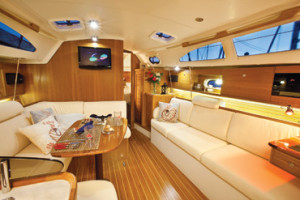 THE INSIDE STORY
THE INSIDE STORY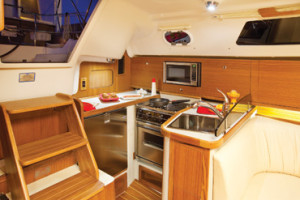 From the base of the companionway ladder, you have the compact but complete galley to port with the U-shaped dinette just forward of it. The dinette can be converted into a double berth with the table lowered and a cushion inserted.
From the base of the companionway ladder, you have the compact but complete galley to port with the U-shaped dinette just forward of it. The dinette can be converted into a double berth with the table lowered and a cushion inserted. DETAILS
DETAILS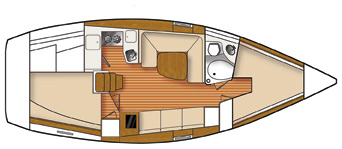
 Dufour 36P • The new racer-cruiser from France is a winner in both categories.
Dufour 36P • The new racer-cruiser from France is a winner in both categories. The cockpit has the main traveler running across the sole just forward of the wheels; the sheet is double-ended, which means you can trim from either side of the cockpit. The cockpit lockers are demountable so you can open up the cockpit when racing with a full crew or you can leave them installed when cruising. Aft, the low transom folds down to make a swim platform with a sturdy stainless steel ladder. A life raft can be stowed aft in a compartment under the cockpit sole.
The cockpit has the main traveler running across the sole just forward of the wheels; the sheet is double-ended, which means you can trim from either side of the cockpit. The cockpit lockers are demountable so you can open up the cockpit when racing with a full crew or you can leave them installed when cruising. Aft, the low transom folds down to make a swim platform with a sturdy stainless steel ladder. A life raft can be stowed aft in a compartment under the cockpit sole. CRUISING ACCOMMODATIONS
CRUISING ACCOMMODATIONS  DESIGN AND CONSTRUCTION
DESIGN AND CONSTRUCTION The hull is foam core above the waterline and solid composite below the waterline. Wide longitudinal stringers run the length of the hull on both sides just above the waterline, which adds to hull stiffness and strength. Inside the hull, the builders use a pan liner to add stiffness, which becomes the foundation for interior joinery and the engine mount, chain plates and keel bolts.
The hull is foam core above the waterline and solid composite below the waterline. Wide longitudinal stringers run the length of the hull on both sides just above the waterline, which adds to hull stiffness and strength. Inside the hull, the builders use a pan liner to add stiffness, which becomes the foundation for interior joinery and the engine mount, chain plates and keel bolts. Blue Jacket 40 • The new Tim Jackett-designed performance cruiser is being built by Island Packet.
Blue Jacket 40 • The new Tim Jackett-designed performance cruiser is being built by Island Packet.  The numbers tell the tale of the Blue Jacket 40’s performance pedigree. The standard design with the deep keel has a sail area-to-displacement ratio of 21.8, which means the rig has plenty of horsepower. The displacement-to-length ratio of 172 puts the boat in the “moderately light” category and indicates that the design will be quick but should also have a pleasant motion going through and over waves. The ballast-to-displacement ratio of 39 percent indicates that the 40 will stand up nicely to the breeze and should easily convert pressure into boat speed.
The numbers tell the tale of the Blue Jacket 40’s performance pedigree. The standard design with the deep keel has a sail area-to-displacement ratio of 21.8, which means the rig has plenty of horsepower. The displacement-to-length ratio of 172 puts the boat in the “moderately light” category and indicates that the design will be quick but should also have a pleasant motion going through and over waves. The ballast-to-displacement ratio of 39 percent indicates that the 40 will stand up nicely to the breeze and should easily convert pressure into boat speed. Tartan Fantail 26 • The new daysailer-weekender from Tartan Yachts packs a lot of performance in a compact package.
Tartan Fantail 26 • The new daysailer-weekender from Tartan Yachts packs a lot of performance in a compact package.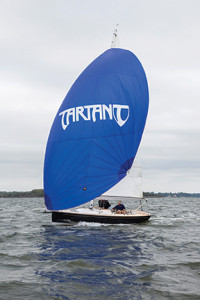 Technically, the Torqeedo is a very interesting propulsion system for a small sailboat. The throttle and gear shifter is linked to a GPS and has a small LED readout that gives you course, speed and remaining powering range. The electric motor is powered by two 4D AGM batteries and a third Group 27 battery is used to power onboard systems such as running lights, reading lights and electronics. With a full charge, the motor will drive the boat at half speed or about 4 knots for 16 hours before the batteries need to be charged again. Tartan provides a shore-power battery charging system and, for those who will keep their boats on moorings, they offer wind and solar charging systems as options.
Technically, the Torqeedo is a very interesting propulsion system for a small sailboat. The throttle and gear shifter is linked to a GPS and has a small LED readout that gives you course, speed and remaining powering range. The electric motor is powered by two 4D AGM batteries and a third Group 27 battery is used to power onboard systems such as running lights, reading lights and electronics. With a full charge, the motor will drive the boat at half speed or about 4 knots for 16 hours before the batteries need to be charged again. Tartan provides a shore-power battery charging system and, for those who will keep their boats on moorings, they offer wind and solar charging systems as options.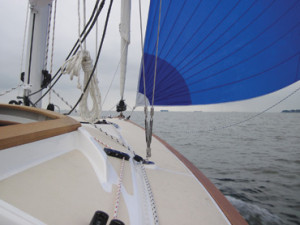 THE DESIGN
THE DESIGN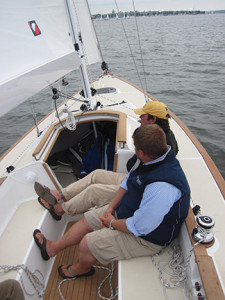 The cockpit is nine feet long, so four adults can fit comfortably and still manage the sheets and control lines without getting in each other’s way. The self-tacking jib certainly reduces sheet clutter in the cockpit. The main sheet is all the way aft, where it is handy to the helm.
The cockpit is nine feet long, so four adults can fit comfortably and still manage the sheets and control lines without getting in each other’s way. The self-tacking jib certainly reduces sheet clutter in the cockpit. The main sheet is all the way aft, where it is handy to the helm. DOWN BELOW
DOWN BELOW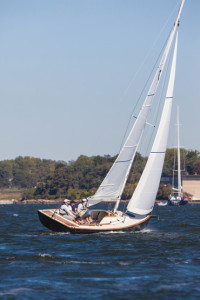 We have something of a soft spot for smaller Tartan designs since we grew up sailing a Tartan 27—parents and three large sons—all over New England as we cruised to PHRF regattas, raced over weekends and then sailed home again. The new Fantail updates the concept by a country mile. The Fantail 26 is less of a cruising boat than a fine daysailer and weekender, which suits today’s sailing styles. Yet, you could take the weekender off for a week at a time and have a very pleasant small boat cruising experience.
We have something of a soft spot for smaller Tartan designs since we grew up sailing a Tartan 27—parents and three large sons—all over New England as we cruised to PHRF regattas, raced over weekends and then sailed home again. The new Fantail updates the concept by a country mile. The Fantail 26 is less of a cruising boat than a fine daysailer and weekender, which suits today’s sailing styles. Yet, you could take the weekender off for a week at a time and have a very pleasant small boat cruising experience. S & S 30 • This Olin Stephens design from 1935, updated by the S&S team, is one of the sweetest little cruisers ever built.
S & S 30 • This Olin Stephens design from 1935, updated by the S&S team, is one of the sweetest little cruisers ever built. The new boat, which is the brain child of yacht dealer and broker Glenn Walters, founder of Bluenose Yacht Sales, takes the pretty lines of the original design, including the thoroughly modern plumb bow and square transom, both of which look current by today’s standards, and marries them to a new underwater profile that includes a shallow hull form, bulbed fin keel and spade rudder. Plus, with a high-tech, cored hull, the 30 is both light and very stiff.
The new boat, which is the brain child of yacht dealer and broker Glenn Walters, founder of Bluenose Yacht Sales, takes the pretty lines of the original design, including the thoroughly modern plumb bow and square transom, both of which look current by today’s standards, and marries them to a new underwater profile that includes a shallow hull form, bulbed fin keel and spade rudder. Plus, with a high-tech, cored hull, the 30 is both light and very stiff.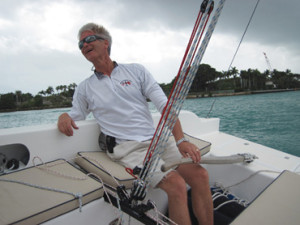 SAIL TRIAL
SAIL TRIAL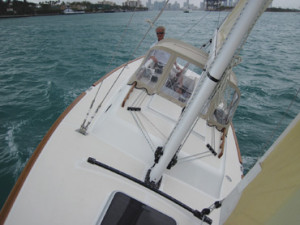 We threw the 30 through a few tacks and noted that she was able to hold happily at about 40 degrees from the true wind and tacked through about 80 degrees. The self tacking jib makes tacking effortless. The mainsail is rigged with a four-part tackle that gives you plenty of mechanical advantage and it has a fine-tuning tackle that lets you trim in minute detail. The traveler runs across the cockpit so you can power the big mainsail up and down as the breeze dictates.
We threw the 30 through a few tacks and noted that she was able to hold happily at about 40 degrees from the true wind and tacked through about 80 degrees. The self tacking jib makes tacking effortless. The mainsail is rigged with a four-part tackle that gives you plenty of mechanical advantage and it has a fine-tuning tackle that lets you trim in minute detail. The traveler runs across the cockpit so you can power the big mainsail up and down as the breeze dictates. CREATURE COMFORTS
CREATURE COMFORTS The New Lagoons Arrive – The new 52 and 39 are the trend setters for the future of the Lagoon fleet.
The New Lagoons Arrive – The new 52 and 39 are the trend setters for the future of the Lagoon fleet. The new 39 was designed to fit into the Lagoon line between the 380 and 4000S2. Almost 700 380s have been built, making it one of the most popular cruising cats in the world. The 39, with the company’s new design thinking and its position in a sweet spot in the market, should become as popular as the previous model.
The new 39 was designed to fit into the Lagoon line between the 380 and 4000S2. Almost 700 380s have been built, making it one of the most popular cruising cats in the world. The 39, with the company’s new design thinking and its position in a sweet spot in the market, should become as popular as the previous model. FLYING THE 52
FLYING THE 52 Catalina Sport Pocket Cruiser Racer • The new 27-foot sport cruiser from Catalina puts the fun back into sailing for those just starting out or those downsizing from a bigger cruising boat.
Catalina Sport Pocket Cruiser Racer • The new 27-foot sport cruiser from Catalina puts the fun back into sailing for those just starting out or those downsizing from a bigger cruising boat. Designed by Catalina’s Gerry Douglas, the new 275 was conceived to be a boat that is simple and fun to sail or even race, uncomplicated to own and maintain and roomy enough for four or five friends to join you for an afternoon of sailing, picnicking and swimming. On top of that, it had to be a capable weekender for a couple or a couple of friends.
Designed by Catalina’s Gerry Douglas, the new 275 was conceived to be a boat that is simple and fun to sail or even race, uncomplicated to own and maintain and roomy enough for four or five friends to join you for an afternoon of sailing, picnicking and swimming. On top of that, it had to be a capable weekender for a couple or a couple of friends. 2013 Boat Show Preview • The fall and winter boat show season is on the horizon and with that comes excitement from not only boat builders, but boat buyers as well. As always, BWS is happy to give you a rundown on what to expect as you tour this year’s shows. For a preview of the newest multihulls, see the August 2013 issue of Multihulls Quarterly.
2013 Boat Show Preview • The fall and winter boat show season is on the horizon and with that comes excitement from not only boat builders, but boat buyers as well. As always, BWS is happy to give you a rundown on what to expect as you tour this year’s shows. For a preview of the newest multihulls, see the August 2013 issue of Multihulls Quarterly. BAVARIA
BAVARIA BENETEAU
BENETEAU BLUE JACKET 40
BLUE JACKET 40 C&C
C&C CATALINA
CATALINA DEHLER
DEHLER  DUFOUR
DUFOUR HANSE
HANSE ISLAND PACKET
ISLAND PACKET JEANNEAU
JEANNEAU J/BOATS
J/BOATS HUNTER
HUNTER  MORRIS YACHTS
MORRIS YACHTS  MOODY
MOODY  PASSPORT
PASSPORT  RUSTLER
RUSTLER  SEAWARD
SEAWARD  S&S 30
S&S 30  Tartan
Tartan 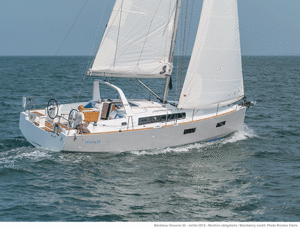 With a unique and flexible design, the Beneteau Oceanis 38 is going to evolve with your sailing style in mind By Andrew Cross
With a unique and flexible design, the Beneteau Oceanis 38 is going to evolve with your sailing style in mind By Andrew Cross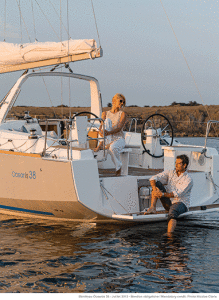 Under power the 30 horsepower Volvo Penta had us humming quickly out of the channel at about 7.5 knots and in perfect position to roll out the sails. With all control lines, halyards and sheets led smartly aft we rolled the Elvstrøm main out first and flattened the foot against the boom as 15 knots of breeze was in store. The boat’s dodger had nice large windows and a rare sunroof that made the main visible without having to stick your head out from underneath to tell sail shape and trim. The dodger was led aft to the 38’s mainsheet arch over the cockpit and from there a bimini took over to provide shade for the rest of the voluminous cockpit.
Under power the 30 horsepower Volvo Penta had us humming quickly out of the channel at about 7.5 knots and in perfect position to roll out the sails. With all control lines, halyards and sheets led smartly aft we rolled the Elvstrøm main out first and flattened the foot against the boom as 15 knots of breeze was in store. The boat’s dodger had nice large windows and a rare sunroof that made the main visible without having to stick your head out from underneath to tell sail shape and trim. The dodger was led aft to the 38’s mainsheet arch over the cockpit and from there a bimini took over to provide shade for the rest of the voluminous cockpit.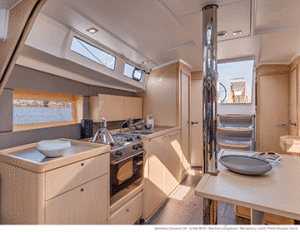 Gone are the days of the dark, library-esq interior styling’s that make you feel as though you’re hiding in a cave. Though it was overcast and dreary outside, the large cabin top windows let a good amount of light in and the overhead hatches added some much needed brightness. In complete contrast to the gloom of that day at the show, when we did our sea trial the sun was beaming bright, causing light to bounce throughout the cabin without seeming like it would turn the boat into an oven or cause it to be too obnoxiously bright. There are shades on every window if too much sunlight seemed like it would be a problem.
Gone are the days of the dark, library-esq interior styling’s that make you feel as though you’re hiding in a cave. Though it was overcast and dreary outside, the large cabin top windows let a good amount of light in and the overhead hatches added some much needed brightness. In complete contrast to the gloom of that day at the show, when we did our sea trial the sun was beaming bright, causing light to bounce throughout the cabin without seeming like it would turn the boat into an oven or cause it to be too obnoxiously bright. There are shades on every window if too much sunlight seemed like it would be a problem. long the starboard side was a small changing seat and then the inline galley with a generous amount of counter space, drawers for storage below and cupboards above, a two burner stove, single sink and refrigerator. Aft of the galley on that side, and on all versions, is a head with shower.
long the starboard side was a small changing seat and then the inline galley with a generous amount of counter space, drawers for storage below and cupboards above, a two burner stove, single sink and refrigerator. Aft of the galley on that side, and on all versions, is a head with shower.